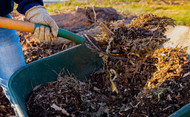Hügelkultur. If you don’t speak German, it’s pronounced ‘hoogle-culture’. What it means is “hill culture” or “mound bed”. While a normal garden bed is flat, in hügelkultur, the bed is in the shape of a small hill. The first time hügelkultur was used in horticulture circles was in the 1960s or 1970s. However, it’s also said that this style of planting has been done for hundreds of years in Germany and Eastern Europe.
But why would you want to garden on a small hill? To the uninitiated, it sounds more complicated than gardening on a simple flat raised bed.
There are some serious advantages to hügelkultur that may make you want to try it this fall.
It can be part of a permaculture garden as it’s a closed system where wastes become resources and everything is recycled.
In hügelkultur, the mound is created by garden waste. Specifically, wood, branches and other greens and browns. Think of it as a long term compost pile. One that lasts five to seven years. That you plant on. Additionally, if successful, you won’t have to fertilize, and depending on your climate, you can reduce your watering needs.



